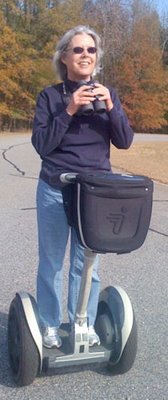Birding on a Segway
Friday, November 28th, 2008
Because back problems have kept me from walking as much as usual for the past several weeks, a friend offered to let me try out a Segway – a battery-powered “self-balancing personal transporter” – and it turned out to be a great new way to go birding. It’s amazingly easy to ride, and so quiet I could hear Yellow-throated Warblers, Ruby-crowned Kinglets, Brown-headed Nuthatches, House Finches, Bluebirds and other little birds as I glided along. The weather was warm and balmy, with five Black Vultures and several Turkey Vultures soaring in a big, open, soft-blue sky.
You can go along at a pretty brisk pace on the Segway – or slow it down so that you’re barely moving forward, or even come to a complete stop and still stay balanced, though I’m not yet confident enough to use my binoculars quickly or easily without getting off. I should mention, also, that I didn’t have a helmet and was riding in a pretty safe area with little traffic – but it’s certainly better to wear one.
Along the Old Field just outside our subdivision, I stepped off the Segway and walked for a while. White-throated Sparrows called from the tangle of dead weeds in the field, and one or two whistled a broken fragment of song. Two Red-tailed Hawks circled very low overhead, slowly making their way higher. One was a juvenile, with a finely-barred tail and a dark-streaked band across the breast. The other was mature, with a red-orange tail that glowed when it turned and caught the sunlight. Just watching the two of them gradually circle and climb, lit from above and suffused in a clear, almost golden light, was enough to make the day.
Back on the Segway and headed back home, I passed a flock of at least 100 Red-winged Blackbirds perched in the limbs of trees in several yards, and stopped to look for Rusty Blackbirds among them, but found only a few Common Grackles. I’m hoping the flock of Rusties we saw regularly the last couple of years will return again this season.
Several Bluebirds and Chipping Sparrows flew up from the grass in one yard as I glided quietly past, and I heard the calls of a Pileated Woodpecker, a Northern Flicker, Golden-crowned Kinglets and a few Robins. All in all, there was nothing remarkable to report, but the Segway gave me the welcome freedom to go a good bit further than usual lately, especially up and down the steep hills I’m not supposed to walk right now. And it was lots of fun!
This Segway model wasn’t meant for off-road use, so I had to stick to the roads, but there are models designed for trails and uneven terrain that are even better for birding. Bill Thompson has a good posting on his Bill of the Birds blog that describes using a Segway for birding through the woods and fields of a farm in southeastern Ohio and includes several photos.